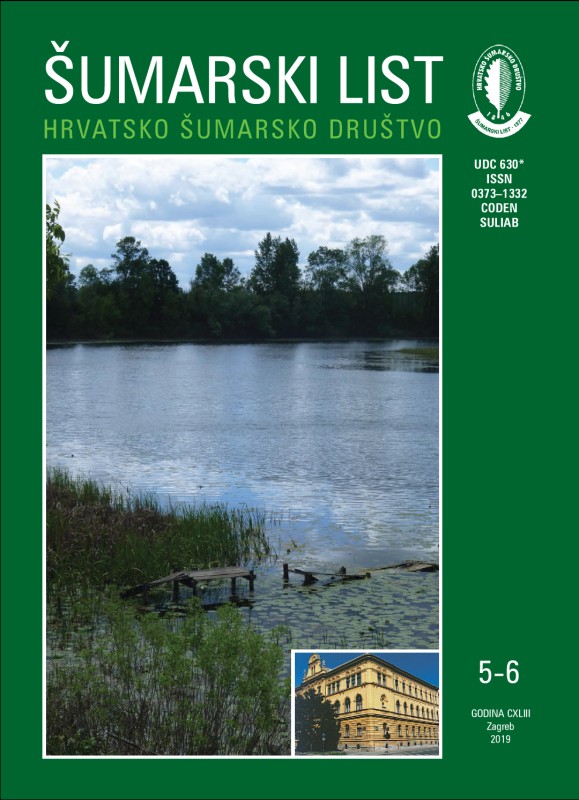
broj: 5-6/2019
pdf (7,52 MB) |
|
||||||||||||||
| IZVORNI ZNANSTVENI ČLANCI | ||
| Krešimir Krapinec, Miroslav Nikolić, Miljenko Bujanić, Dean Konjević | UDK 630* 156 (001) https://doi.org/10.31298/sl.143.5-6.1 | |
| Considerations in the study of trophies: The effect of skull cutting on the real value of roe buck trophies pdf HR EN | 203 | |
| Milivoj Franjević, Zoran Šikić, Boris Hrašovec | UDK 630* 453 (001) https://doi.org/10.31298/sl.143.5-6.2 | |
| First occurrence of Xylosandrus germanus (Blandford, 1894) – black steam borer in pheromone baited panel traps and population build up in Croatian oak stands pdf HR EN | 215 | |
| Nikola Šušić, Martin Bobinac, Siniša Andrašev, Mirjana Šijačić-Nikolić, Andrijana Bauer-Živković | UDK 630* 232.3 + 815 (001) https://doi.org/10.31298/sl.143.5-6.3 | |
| Growth characteristics of one-year-old Hungarian oak seedlings (Quercus frainetto Ten.) in full light conditions pdf HR EN | 221 | |
| Ayhan Usta, Murat Yilmaz, Selvinaz Yilmaz, Yavuz Okunur Kocamanoglu, Esengül Genc, Ibrahim Turna | UDK 630* 242 (001) https://doi.org/10.31298/sl.143.5-6.4 | |
| The effects of thinning intensity on the growth of oriental beech (Fagus orientalis Lipsky) plantations in Trabzon, NE Turkey pdf HR EN | 231 | |
| Yilmaz Turk, Murat Yildiz | UDK 630* 377 + 424 (001) https://doi.org/10.31298/sl.143.5-6.5 | |
| The effects of wood chips and slash usage on skid trail sheet erosion caused by log skidding using a farm tractor pdf HR EN | 241 | |
| PRETHODNO PRIOPĆENJE | ||
| Kenan Zahirović, Osman Mujezinović, Mirza Dautbašić | UDK 630* 453 https://doi.org/10.31298/sl.143.5-6.6 | |
| First record of parasitod (Platygaster robiniae) on black locust gall midge in Bosnia and Herzegovina pdf HR EN | 251 | |
| STRUČNI ČLANCI | ||
| Ivana Plišo Vusić, Irena Šapić, Joso Vukelić | UDK 630* 181.6 + 187 https://doi.org/10.31298/sl.143.5-6.7 | |
| Identification and mapping of Natura 2000 forest habitat types in Croatia (I) – 91E0*alluvial forest with black alder Alnus glutinosa and common ash Fraxinus excelsior (Alno-Padion, Alnion incanae, Salicion albae) pdf HR EN | 255 | |
| Summary Habitat type 91E0 in Croatia extends to approximately 80,000 ha. It contains 16 types according to the National habitat classification of Croatia (NHC). They are based on phytosociological principles and are aligned with the level of association. They are: E.1. Riparian alluvial willow forests (Salicion albae Soó 1930), poplar (Populion albae Br.-Bl. 1931) and white alder forests (Alnion incanae Pawl. in Pawl. et al. 1928) Riparian alluvial willow and poplar forests (Salicion albae, Populion albae) E.1.1.1. – Salicetum albae-fragilis Soó (1930) 1958 E.1.1.2. – Salicetum albae Isller 1926 E.1.1.3. – Salici-Populetum nigrae (R. Tx. 1931) Meyer Drees 1936 E.1.2.1. – Populetum albae (Br.-Bl.) Tchou 1947 E.1.2.2. – Populetum nigro-albae Slavnić 1952 Alluvial white alder forests (Alnion incanae) E.1.3.1. – Equiseto hyemali-Alnetum incanae M. Moor 1958 E.1.3.2. – Lamio orvalae-Alnetum incanae Dakskobler 2010 E.2. Floodplain forests of pedunculate oak, black alder and narrow-leaved ash (Alnion glutinosae Malcuit 1929, Alnion incanae) Swamp and floodplain forests of black alder narrow-leaved ash (Alnion glutinosae) E.2.1.4. – Frangulo-Alnetum glutinosae Rauš (1971) 1973 E.2.1.6. – Carici elongatae-Alnetum glutinosae W. Koch 1926 ex Tx. 1931 E.2.1.7. – Leucojo-Fraxinetum angustifoliae Glavač 1959 E.2.1.9. – Carici acutiformis-Alnetum glutinosae Scamoni 1935 Alluvial and wetland forests of black alder, elms, narrow-leaved and common ash (Alnion incanae) E.2.1.1. – Fraxino angustifoliae-Ulmetum laevis Slavnić 1952 E.2.1.2. – Carici remotae-Fraxinetum excelsioris W. Koch 1926 ex Faber 1936 E.2.1.3. – Carici brizoidis-Alnetum glutinosae Horvat 1938 E.2.1.5. – Pruno-Fraxinetum angustifoliae Glavač 1960 E.2.1.8. – Stellario nemorum-Alnetum glutinosae Lohmayer 1957 The article contains a description, area of distribution in Croatia, and diagnostic indicators for each type. For each type related types are listed, the corresponding code according to EUNIS-classification, and literature in which is described in more detail. This article has practical importance because it helps in the identification and mapping of forest habitat types, and these tasks are currently being implemented in the Croatian forestry. Key words: 91E0* Natura 2000 habitat type; National habitat classification; Forest habitat types; hygrophilous species; Croatia | ||


